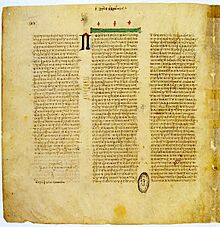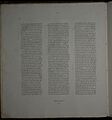Codex Vaticanus facts for kids
| New Testament manuscript | |

Page from Codex Vaticanus; ending of 2 Thes and beginning of Heb
|
|
| Name | Vaticanus |
|---|---|
| Sign | B |
| Text | Greek Old Testament and Greek New Testament |
| Date | 4th Century |
| Script | Greek |
| Now at | Vatican Library |
| Cite | C. Vercellonis, J. Cozza, Bibliorum Sacrorum Graecus Codex Vaticanus, Roma 1868. |
| Size | 27 × 27 cm (10.6 × 10.6 in) |
| Type | Alexandrian text-type |
| Category | I |
| Note | very close to 𝔓66, 𝔓75, 0162 |
The Codex Vaticanus is a very old Christian book. It contains most of the Greek Old Testament and the Greek New Testament. It is known by the special code B or 03.
This ancient book is one of the four most important early Bible manuscripts. Along with the Codex Alexandrinus and Codex Sinaiticus, it is one of the oldest and most complete Bibles we have. Experts believe it was written in the 4th century. This means it is about 1,600 years old!
Scholars in the Western world learned about this codex through letters. These letters were between a famous scholar named Erasmus and the Vatican Library. In the 19th century, the full text of the codex was finally copied. This helped scholars see how it was different from other common Bible texts.
Today, many experts believe the Codex Vaticanus is one of the most important Greek copies of the New Testament. It was used a lot by scholars like Brooke Foss Westcott and Fenton John Anthony Hort. Their work helped create modern Greek New Testament editions. These editions are often based on the text of the Codex Vaticanus. It is truly considered the oldest existing copy of the Bible. The codex is kept safe in the Vatican Library. It has been there since at least the 1400s.
Contents
What is the Codex Vaticanus?
The Codex Vaticanus is a type of ancient book called a codex. It is made of 759 pages of very fine, thin vellum. Vellum is like a special type of parchment made from animal skin. Each page measures about 27 by 27 centimeters. The book was originally even bigger.
The text is written in uncial letters. These are large, capital letters. There are three columns of text on each page. Each column has 40 to 44 lines. The letters are written close together. There are no spaces between words, so each line looks like one long word.
- The first five books of the Old Testament have 44 lines per column.
- The New Testament always has 42 lines per column.
This codex is special because it has three columns per page. Only a few other Greek Bible manuscripts are written this way. Later, someone traced over the original writing. They also added accents and punctuation.
What Bible books are in it?
The Codex Vaticanus originally had almost all of the Septuagint. This is the Greek version of the Old Testament. Some parts were missing, like a few books of Maccabees. The first part of Genesis and some Psalms were also lost. These missing parts were added later by a different writer in the 1400s.
The Old Testament books are in a specific order. For example, the Book of Daniel comes after Ezekiel. This order is different from some other ancient Bibles.
The New Testament part of the codex has:
- The Gospels (Matthew, Mark, Luke, John)
- Acts
- The general epistles (like James, Peter, John, Jude)
- The Pauline epistles (letters from Paul)
- The Epistle to the Hebrews (but it's not complete)
Some books are missing from the New Testament section. These include 1 and 2 Timothy, Titus, Philemon, and Revelation. The missing parts were also added later by a writer in the 1400s.
How was it written?
Experts believe two main scribes wrote the Codex Vaticanus. Scribe A wrote parts of the Old Testament. Scribe B wrote other parts of the Old Testament and the entire New Testament.
Later, someone else went over the original writing. This person added accents, breathing marks, and punctuation. The original writing was very neat.
The codex has small double dots in the margins. These are called "distigmai." There are about 795 of them in the New Testament. Scholars think these dots show places where the writer knew about different ways the text could be read. It means there was some uncertainty about the exact wording in those spots.
On one page, next to Hebrews 1:3, there is a note in the margin. It says, "Fool and knave, leave the old reading and do not change it!" This note might show that people were trying to correct or change the text without permission.
Where did it come from?
No one is completely sure where the Codex Vaticanus was first written. Some scholars think it might have been in Rome. Others suggest Alexandria in Egypt or Caesarea.
Many clues point to Egypt or Alexandria. The way the text is written is similar to other Egyptian manuscripts. Also, the order of some books, like Paul's letters, is similar to Egyptian versions.
It is thought that the codex might have been in Caesarea in the 500s. This is because it shares a unique way of dividing chapters in the book of Acts with the Codex Sinaiticus. It likely came to Italy from Constantinople after the Council of Florence (1438–1445).
The codex has been in the Vatican Library for a very long time. It was probably listed in the library's first catalog in 1475. It was definitely in the 1481 catalog.
How did scholars study it?
For a long time, it was very hard for scholars to study the Codex Vaticanus. The Vatican Library was very protective of it. They would not let scholars make full copies or study it closely.
One scholar, Samuel Prideaux Tregelles, tried to study it in the 1840s. He said they would search his pockets and take away his pen and paper. Two church officials would talk to him constantly. If he looked at a passage for too long, they would take the book away!
Because of this, it was hard to get a good copy of the text. The first full printed edition was made by Angelo Mai between 1828 and 1838. But it had many errors.
Finally, in 1889–1890, a full photographic copy of the manuscript was made. This meant scholars all over the world could finally study the Codex Vaticanus. In 1999, a special full-color copy was made. Today, you can even see a digital copy of the codex online from the Vatican Library.
Why is it important?
The Codex Vaticanus is one of the most important manuscripts for studying the Septuagint (Greek Old Testament) and the Greek New Testament. It is a top example of the Alexandrian text-type. This text-type is considered very reliable by many scholars.
It was a key source for the famous 1881 edition of The New Testament in the Original Greek by Westcott and Hort. Many modern editions of the New Testament still rely heavily on the text found in the Codex Vaticanus.
Experts agree that it is the most important manuscript for the Gospels, Acts, and the general epistles. It is considered as important as the Codex Sinaiticus. The Codex Vaticanus is truly a treasure for understanding the Bible's ancient text.
Images for kids
-
The end of Mark in Vaticanus contains an empty column after Verse 16:8, possibly suggesting that the scribe was aware of the missing ending. It is the only empty New Testament column in the Codex.






